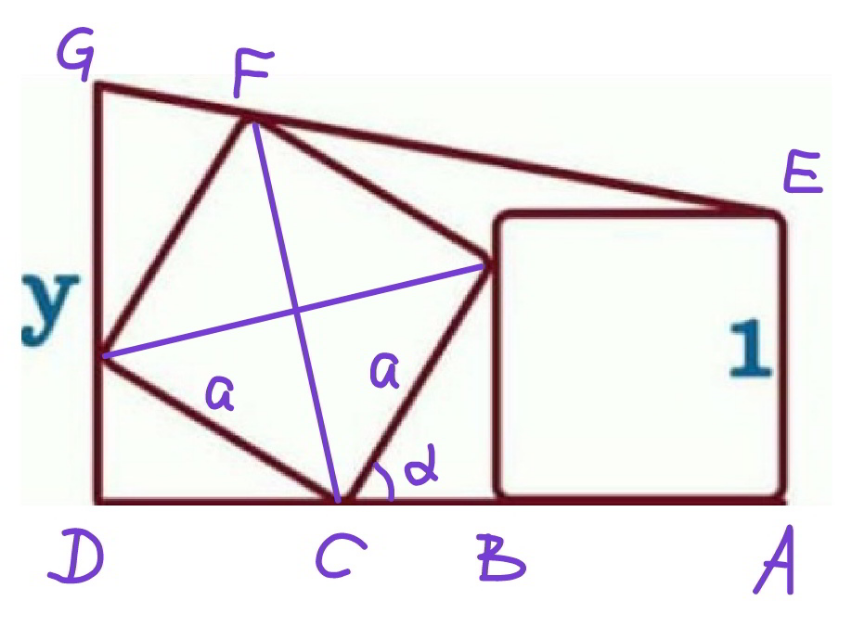Question Number 156509 by ARUNG_Brandon_MBU last updated on 12/Oct/21

Commented by mr W last updated on 12/Oct/21

$${both}\:{squares}\:{are}\:{of}\:{equal}\:{size}? \\ $$
Commented by ARUNG_Brandon_MBU last updated on 12/Oct/21

$$\mathrm{I}\:\mathrm{don}'\mathrm{t}\:\mathrm{really}\:\mathrm{know}\:\mathrm{Sir}.\:\mathrm{I}\:\mathrm{think}\:\mathrm{so}\:\mathrm{too} \\ $$
Commented by mr W last updated on 12/Oct/21

$${for}\:{unique}\:{solution}\:{the}\:{size}\:{of}\:{both} \\ $$$${squares}\:{must}\:{be}\:{given}. \\ $$
Commented by ARUNG_Brandon_MBU last updated on 12/Oct/21

$$\mathrm{OK}\:\mathrm{Sir}.\:\mathrm{But}\:\mathrm{the}\:\mathrm{question}\:\mathrm{is}\:\boldsymbol{\mathrm{How}}\:\boldsymbol{\mathrm{big}}\:\boldsymbol{\mathrm{is}}\:\boldsymbol{\mathrm{y}}? \\ $$
Commented by mr W last updated on 12/Oct/21

$${the}\:{question}\:{is}\:{how}\:{big}\:{can}\:{y}\:{be}. \\ $$$${if}\:{the}\:{second}\:{square}\:{is}\:{the}\:{same}\:{as} \\ $$$${the}\:{first}\:{one},\:{then}\:\mathrm{1}\leqslant{y}\leqslant\mathrm{1}.\mathrm{6006}. \\ $$
Answered by mr W last updated on 12/Oct/21

Commented by mr W last updated on 12/Oct/21

$${CB}={a}\:\mathrm{cos}\:\alpha \\ $$$${CD}={a}\:\mathrm{sin}\:\alpha \\ $$$${x}_{{F}} =\mathrm{1}+{a}\:\mathrm{cos}\:\alpha+\sqrt{\mathrm{2}}{a}\mathrm{cos}\:\left(\mathrm{45}+\mathrm{90}−\alpha\right) \\ $$$${x}_{{F}} =\mathrm{1}+{a}\:\mathrm{cos}\:\alpha+\sqrt{\mathrm{2}}{a}\:\mathrm{sin}\:\left(\alpha−\mathrm{45}\right) \\ $$$${x}_{{F}} =\mathrm{1}+{a}\:\mathrm{cos}\:\alpha+{a}\:\left(\mathrm{sin}\:\alpha−\mathrm{cos}\:\alpha\right) \\ $$$${x}_{{F}} =\mathrm{1}+{a}\:\mathrm{sin}\:\alpha \\ $$$${y}_{{F}} =\sqrt{\mathrm{2}}{a}\:\mathrm{sin}\:\left(\mathrm{45}+\mathrm{90}−\alpha\right) \\ $$$${y}_{{F}} =\sqrt{\mathrm{2}}{a}\:\mathrm{cos}\:\left(\alpha−\mathrm{45}\right) \\ $$$${y}_{{F}} ={a}\:\left(\mathrm{cos}\:\alpha+\mathrm{sin}\:\alpha\right) \\ $$$$\frac{{y}−\mathrm{1}}{\mathrm{1}+{a}\left(\mathrm{cos}\:\alpha+\mathrm{sin}\:\alpha\right)}=\frac{{a}\left(\mathrm{cos}\:\alpha+\mathrm{sin}\:\beta\right)−\mathrm{1}}{\mathrm{1}+{a}\:\mathrm{sin}\:\alpha} \\ $$$${for}\:{a}=\mathrm{1}: \\ $$$${y}=\mathrm{1}+\frac{\mathrm{sin}\:\mathrm{2}\alpha}{\mathrm{1}+\mathrm{sin}\:\alpha} \\ $$$${y}_{{max}} \approx\mathrm{1}.\mathrm{6006} \\ $$
Commented by ARUNG_Brandon_MBU last updated on 12/Oct/21

$$\mathrm{Thank}\:\mathrm{you}\:\mathrm{Sir} \\ $$
Commented by Tawa11 last updated on 12/Oct/21

$$\mathrm{great}\:\mathrm{sir}. \\ $$
